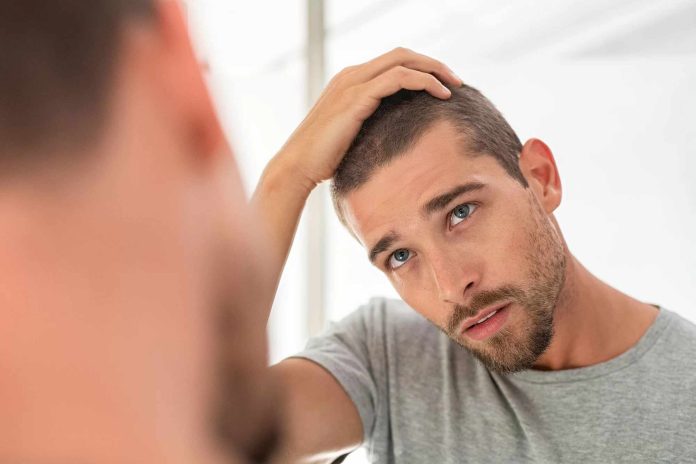Hair loss is a common issue that affects billions of people around the world, regardless of age or gender. However, despite the vast amount of information available, numerous fearful myths about hair loss have propagated over time. Rather than get caught up in confusion and misconceptions, read on to learn the truth about five common hair-loss myths.
Table of Contents
1. Wearing Hats Causes Hair Loss
One of the most common hair loss myths is that wearing a hat will cause your hair to fall out. However, this blanket statement is not generally true. The truth is that excessively tight headwear and hair ties can lead to a condition known as traction alopecia.
Traction alopecia is a condition characterized by hair loss due to constant tension. The longer excessive tension is placed on your hair follicles, the higher the chance they’ll experience follicular miniaturization. As the name suggests, this process involves the gradual shrinking of the affected follicles, eventually leading to weaker hair. Over time, these damaged follicles may become unable to produce new hair, resulting in overall loss.
The good news is that you can avoid developing traction alopecia by simply wearing headwear that fits properly. You might also consider using claw clips, bandanas, or scrunchies to tie up longer hair, rather than standard hair ties. Doing so is a great way to show off your personal style while keeping your hair healthy.
2. Hair Treatments Don’t Work
Another common myth is that hair treatment medications are ineffective in combating hair loss. Unfortunately, this myth has led many people to avoid taking medication that could otherwise help them. In reality, there are many excellent FDA-approved medications that have shown significant success in doing just that.
For instance, minoxidil and finasteride are two medications widely recognized for their effectiveness in addressing male pattern baldness (MPB). Also known as androgenetic alopecia, MPB affects roughly two-thirds of men worldwide. These medications tackle this common condition by promoting hair growth and slowing its loss.
While individual results may vary, many people have experienced positive results from using these forms of hair loss treatment. Consider using either medication if you’re experiencing hair loss and haven’t tried them yet. They may be exactly what you need.
3. Frequent Shampooing Leads to Hair Loss
Many people incorrectly believe that frequent shampooing can contribute to hair loss. However, washing your hair is not the issue at hand here. In fact, keeping your scalp clean is crucial for maintaining your hair’s overall health. In this regard, not shampooing your hair may actually be more detrimental.
This myth may have developed because of the prevalence of shampoos on the market that contain harsh chemicals. Too much exposure to these chemicals, scrubbing vigorously, or rough towel drying can damage your follicles. And this follicle damage can lead to breakage or temporary hair loss.
When cleaning your hair, make sure to use a mild, sulfate-free shampoo. As for drying, use a towel made of a soft fabric. You could even use a T-shirt to pat your hair dry. Find products and a bathing routine you can rely on and rest assured your hair is safe.
4. Shaving Your Hair Makes It Thicker
There is a misconception that shaving your hair can stimulate growth or make it grow back thicker and fuller. This has led to some shaving their head in an attempt to restore their hair to its original strength. However, this belief is pure myth.
Hair growth occurs because of the follicles beneath the surface of your scalp. Like pulling weeds without the roots, shaving only removes the visible portion of the hair shaft. Thus, shaving does not affect the follicles themselves or their natural growth cycle. It only causes growth to take longer because, well, the hairs are now shorter than before.
Shaving may create the illusion of thicker hair temporarily, however, but don’t be fooled. The blunt ends of shaved hairs may simply appear thicker than the naturally-tapered ends of longer hair. Anyone claiming that shaving can actually increase your hair’s natural thickness has also been deceived by this myth. Instead of believing it, devote your energy to exploring evidence-based treatment.
5. Hair Loss (Only) Comes From Your Mother
A myth that’s been passed down for generations is that hair loss is maternal. And it is indeed true that genes for hair loss can be inherited from your mother. However, don’t go blaming her for your bald spots entirely, because the truth is a bit more complicated.
Which genes are activated and which aren’t is not as simple as drawing a Punnett Square. It’s important to understand that hair loss inheritance involves a combination of factors. Androgenetic alopecia, the most common form of hair loss, can be influenced by genes from either parent.
You can do genetic testing to discover whether you have any genes associated with hair loss. That way, if you’re not already balding, you can find out whether or not you might in the future. But typically, you can also look to the men in your family to see if the gene is present. If your father and grandfather are hiding bald spots under their hats, it’s likely you’ll experience hair loss at some point.
Myths Obscure the Truth
There are many myths about hair loss that continue to spread. It’s a common yet complicated condition that can deeply affect your emotional well-being. All the more reason why it’s important to debunk these myths. Understanding the true causes of hair loss can empower you to make more informed decisions about your hair care.




